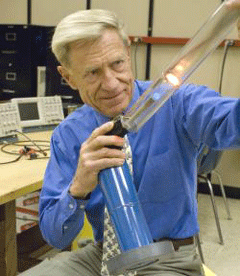Note on Emerging Science
Air Date: Week of June 29, 2007

Physicist Orest Symko uses a blowtorch to heat a metallic screen inside a plastic tube. The metallic screen produces a loud tone that can be used to generate electricity. (Courtesy of University of Utah)
Scientists have figured out how to turn heat into a sound wave that will generate electricity. Amy Fish reports.
Transcript
CURWOOD: Coming up: turtles eat it, sea birds eat it…even tiny shrimp eat it. Plastic is finding its way into every part of the marine food chain. But first this Note on Emerging Science from Amy Fish. And you’re listening to Living on Earth.
FISH: Listen up! This could be the sound of a new renewable energy source—cheap, portable, and fueled only by waste heat.
[SCIENCE NOTE THEME]
Scientists at the University of Utah start by turning the disorderly energy of heat into a pure, single-frequency sound, using a tube-shaped resonator small enough to fit in the palm of your hand. The resonator contains a stack of plates or fibers. When the tube is heated at one end, the expanding air inside diffuses toward the cold air at the other end. The movement of the air through the stack causes vibrations, which in turn produce a sound wave.

Physicist Orest Symko uses a blowtorch to heat a metallic screen inside a plastic tube. The metallic screen produces a loud tone that can be used to generate electricity. (Courtesy of University of Utah)
[SOUND]
Some versions of the resonators produce 135 decibels. That’s the noise level of a jackhammer. But don’t worry about the racket—researchers promise any sound can easily be muffled.
Once they’ve produced the sound, the Utah scientists use a long-understood phenomenon called the piezoelectric effect to turn the sound waves into electricity. Each cubic centimeter of tube produces about one watt of power.
The devices are small, durable, and cheap to produce, so they might make good portable electricity sources for outfits like the U.S. Army, which is funding the research. And scientists say they could power the process with just about any heat source, from power plant waste heat to a running computer—even the heat of sun.
So—it looks like a little hot air might be useful after all.
Links
Living on Earth wants to hear from you!
Living on Earth
62 Calef Highway, Suite 212
Lee, NH 03861
Telephone: 617-287-4121
E-mail: comments@loe.org
Newsletter [Click here]
Donate to Living on Earth!
Living on Earth is an independent media program and relies entirely on contributions from listeners and institutions supporting public service. Please donate now to preserve an independent environmental voice.
NewsletterLiving on Earth offers a weekly delivery of the show's rundown to your mailbox. Sign up for our newsletter today!
 Sailors For The Sea: Be the change you want to sea.
Sailors For The Sea: Be the change you want to sea.
 The Grantham Foundation for the Protection of the Environment: Committed to protecting and improving the health of the global environment.
The Grantham Foundation for the Protection of the Environment: Committed to protecting and improving the health of the global environment.
 Contribute to Living on Earth and receive, as our gift to you, an archival print of one of Mark Seth Lender's extraordinary wildlife photographs. Follow the link to see Mark's current collection of photographs.
Contribute to Living on Earth and receive, as our gift to you, an archival print of one of Mark Seth Lender's extraordinary wildlife photographs. Follow the link to see Mark's current collection of photographs.
 Buy a signed copy of Mark Seth Lender's book Smeagull the Seagull & support Living on Earth
Buy a signed copy of Mark Seth Lender's book Smeagull the Seagull & support Living on Earth

